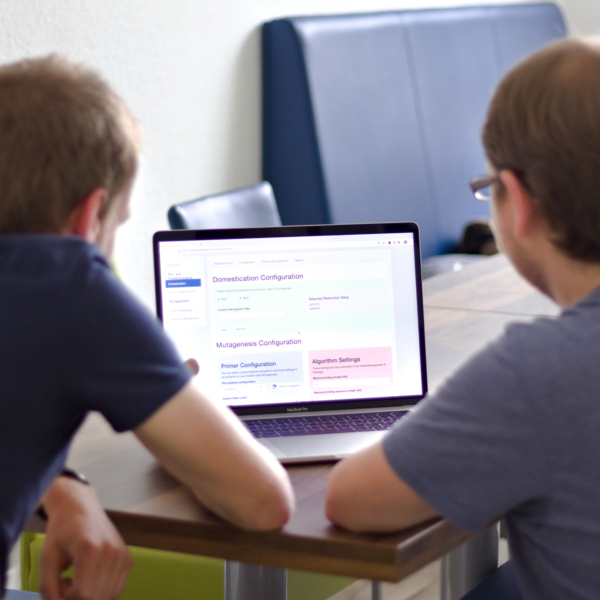IPB scientists have developed Golden Mutagenesis, a fast and efficient method for site-directed mutagenesis and an accompanying web tool for primer design and evaluation. They recently presented their results in Scientific Reports. Biologists, chemists and computer scientists from different research groups of the institute worked together during the development – first and foremost the two PhD students and first authors of the study, Pascal Püllmann (Bioorganic Chemistry Group) and Chris Ulpinnis (Bioinformatics & Mass Spectrometry Group).
In the Bioorganic Chemistry lab, researchers are working on the optimization of enzymes by introducing random or rational mutations and subsequently testing the enzyme function. Pascal Püllmann and his supervisor Martin Weissenborn faced the challenge that until now there were only complex, impractical solutions to perform many mutagenesis reactions in parallel and at the same time in a saturating manner – that is, covering all possible amino acid exchanges. To develop a solution, they teamed up with Sylvestre Marillonnet, an expert in molecular biology tools and group leader of the Synthetic Biology lab.
Together, they created a new mutagenesis protocol based on the Golden Gate cloning method established by Marillonnet and used by many researchers at the IPB and beyond. "Pascal's case was clear: he needed an effective method that would provide him with a library of mutated enzymes”, says Marillonnet, “With Golden Mutagenesis we have now developed the appropriate technique.”
The underlying Golden Gate method uses restriction enzymes that do not cut DNA directly inside a recognition sequence but just outside of it. Thus, one can generate DNA fragments with customized overhangs. In Golden Mutagenesis, recognition sequence, overhang, and mutations are incorporated into the fragments using special primers. The subsequent combined reaction of restriction (cutting) and ligation (joining) allows the rapid, orderly assembly of the mutagenized DNA fragments. "Together with Sylvestre, we created the necessary plasmids and developed a workflow that meets all requirements in an elegant and time-saving manner," reports Püllmann, "but the complicated primer design really was a bottleneck, because it required taking into account many parameters."
Therefore, the scientists came up with the idea to automate the primer design and thereby opening the technology to a wider circle of users. Weissenborn recalls: "We share the building and the social room with the institute’s bioinformaticians. So we just asked our colleagues next door whether they could help us with the automation." The answer was “Yes!” and PhD student Chris Ulpinnis from the Bioinformatics group set out to develop.
"We met regularly to discuss the implementation. Pascal explained a primer design case to me and I kept improving the prototype. This is how we gradually developed the algorithm," says Ulpinnis who also mastered the time-consuming programming of a user-friendly user interface. Group leader Steffen Neumann adds, "It was important for us to develop the tool from the very beginning on the basis of cloud-based services and to pursue an open source concept.”
With the Golden Mutagenesis Web Tool, users can upload the DNA sequence of interest, select positions to mutate, determine the type of mutations, and individually adapt various other parameters. The tool then suggests the appropriate fragments and corresponding primers - even for randomized saturation mutagenesis. After carrying out the mutagenesis reactions in the lab, the sequencing results can be uploaded to the tool for evaluation.
When asked about the interdisciplinary communication between the project’s participants, Neumann summarizes: "Interestingly, we noticed that chemists and biologists initially oversimplify the problem for the bioinformatician. But it is often better to consider all cases from the outset when designing the program.” All in all, however, the researchers agree that the spatial proximity of their groups has made this interdisciplinary project possible in the first place, and they are very pleased about the successful publication.
Original publication:
Püllmann, P.; Ulpinnis, C.; Marillonnet, S.; Gruetzner, R.; Neumann, S.; Weissenborn, M. J. Golden Mutagenesis: An efficient multi-site-saturation mutagenesis approach by Golden Gate cloning with automated primer design Sci Rep 9, 10932, (2019) DOI: 10.1038/s41598-019-47376-1



